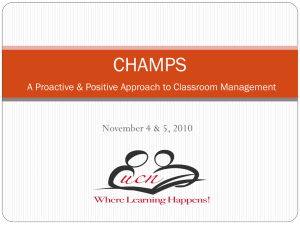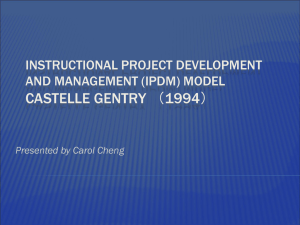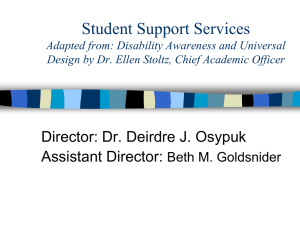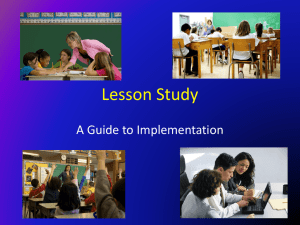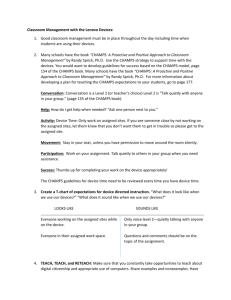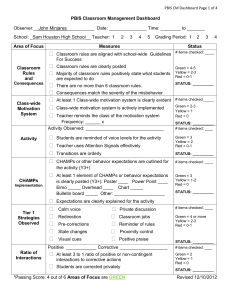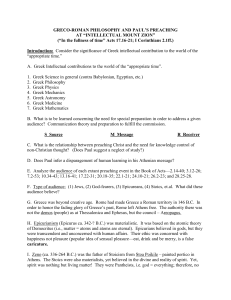Champs - Utah Personnel Development Center
advertisement
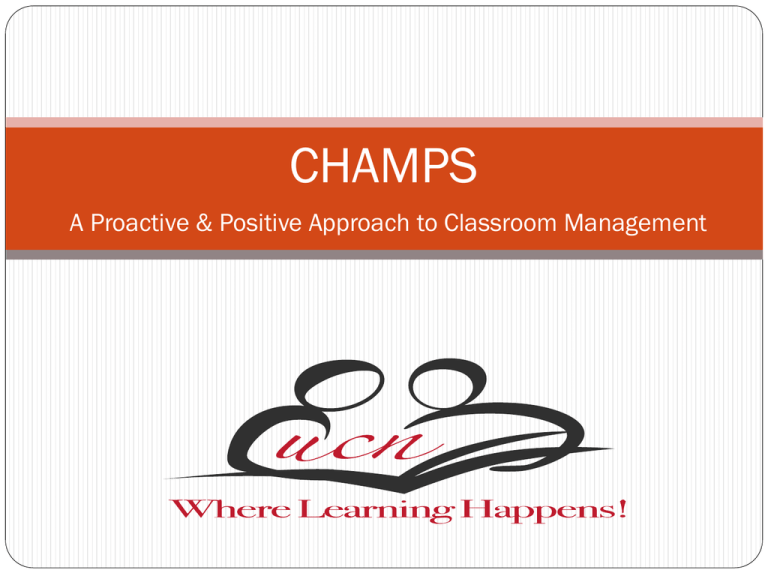
CHAMPS A Proactive & Positive Approach to Classroom Management Review What does STOIC stand for? Each chapter starts with a list of T_________ Each chapter ends with a S_____ __________ Review What are the components of classroom management that add STRUCTURE to your classroom? STOIC Structure of classroom Differentiated Levels of Structure pg. 113 How much structure? Page 195 – 200 Review What does CHAMPS stand for? CHAMPS worksheets are developed for all… I___________ A________ & T____________ STOIC Teaching CHAMPS Three step communication process Teach CHAMPS expectations Monitor student behavior Provide feedback Teach students how to behave responsibly in the classroom pg 209 Three-Step Process for Communicating Expectations Group Groups of 3 1 takes STEP 1 pg 209 2 takes STEP 2 pg 210 3 takes STEP 3 pg 211 At signal 1 will share Rotate at next signal Putting It All Together STEP 1 Greet Students at the door STEP 2 Gain Students Attention STEP 3 Direct Students to Posted Schedule – Review schedule STEP 4 Identify Next Instructional Activity STEP 5 Teach/Review Expectations for Instructional Activity STEP 6 Pre-Correct Potential Problem Behaviors STEP 7 Observe Student Behavior During Instructional Activity STEP 8 Provide Feedback During Activity & At the End A. Positive B. Corrective STEP 9 Repeat for Next Activity Review With Partner – Putting It All Together – Think about the order of the steps Write the steps down Tell your partner – 2’s first – then 1’s Compare Putting It All Together STEP 1 Greet Students at the __________ STEP 2 Gain Students ___________ STEP 3 Direct Students to Posted ___________ – Review schedule STEP 4 Identify Next Instructional ___________ STEP 5 Teach/Review _________________ for Instructional Activity STEP 6 ________________ Potential Problem Behaviors STEP 7 _____________ Student Behavior During Instructional Activity STEP 8 Provide _____________ During Activity & At the End A. _________ B. __________ STEP 9 Repeat for Next ____________ Putting It All Together STEP 1 Greet Students at the door STEP 2 Gain Students Attention STEP 3 Direct Students to Posted Schedule – Review schedule STEP 4 Identify Next Instructional Activity STEP 5 Teach/Review Expectations for Instructional Activity STEP 6 Pre-Correct Potential Problem Behaviors STEP 7 Observe Student Behavior During Instructional Activity STEP 8 Provide Feedback During Activity & At the End A. Positive B. Corrective STEP 9 Repeat for Next Activity Consistency with Routine? STOIC – Observe How does the teacher know if students understand the expectations? STOIC – Observe How does the teacher know if students understand the expectations? As a Coach – How can you help in this process? Group CASE STUDY – Review the case study for Mr. Jepson Discuss possible recommendations – See page 99 CHAMPS Keep track of additional questions you may have. ( !" #$% &' $() " * +,- ) &$(" . #,/ ,0 * $* ,1&2 2 * % 3, ! " #$%" &'())))))))))))))))))))))((* #+" '())))))))))))))))))))))))((! ,- " '(()))))))))))))))))))))))( . /0" &1" &'()))))))))))))))))))))(23#00'(())))))))))))))))))))))))(4$+,1,+5'()))))))))))))))))))))( ( !" #$% &' $() " * +,- ) &$(" . #, 6" 0078(* " 3,1" &5( * " 0$&,9+,78( 23#00(<+#&+" &(( <+#+" =(6" 0078(. />" $+,1" ( ? " 1," @( ! " #$%" &(A 7=" 3(BC(=7D( EF,=" =(G&#$+,$" (BH " (=7D( A #0+" &5(+7(I J K (/" L7&" ( - 71,8M(78(+7(C8=:(G&#$+,$" ( C8=:(G&#$+,$" (BN7F(=7D( ? " 1," @O2370F&" ( 6" 0078(7/>" $+,1" (- #0+" &" =P((( Q7@(- " #0F&" =P( . /0:( ; 7+(. /0:( ; 7+" 0( ( ( ( ( ( ( ( ( ( ( ( ( ( ( ( ( ( ( ( ( ( ( ( ( ( ( ( . +%" &(R3" - " 8+0( * " 0$&,9+,78( 2F" S(G#F0" (<,M8#3P( A #+" &,#30(7&M#8,T" =P( 4=#9+#+,780(8" " =" =P(( 4=#9+#+,780(,- 93" - " 8+" =P( . /0:( ( ( ( ( ; 7+(. /0:( ; 7+" 0( ( ( ( ( ( ( ( ( ( 0 * $* ,1&2 2 * % 3, _ " %#1,7&( ? " =( N" 337@( E&" " 8( 4$+,78(G3#8( ` (+7(a(? #+,7( b(X'X( X'X( c (d'X( ( . ! ? e0( J f] O- ,8( gfhO- ,8( ^fI O- ,8( ( R&&7&(27&&" $+,78( bi hK ( i hfYYK ( XJ J K ( ( * ,0&F9+,780( c (XJ ( hfXJ ( b(h( ( 4$#=:(R8M#M" - " 8+( b(I J K ( I XfYJ K ( YXfXJ J K ( ( ? " =(j (<+79kk(B=7(07- " +%,8M(=,LL" &" 8+D((( N" 337@(j (2#F+,78(B#$+,78(93#8(8" " =" =D(((( E&" " 8(j (Z " " 9(M7,8Mkkk( ( (((((( (((UC- 97&+#8+(#&" #0(7L(0+&F$+F&" (+7(377V(#+(,8$3F=" (+%" (=#,35(0$%" =F3" S(&77- (3#57F+S( STOIC Chapter 9 - Correcting Fluently 355 Review self assessment Chapter 3 Review Classroom Management plan Corrective Procedures Encouragement Procedures Review positive interactions with student Problem solve with chronic misbehavior Page 195 – 200 Behavior and Educational Strategies for Teachers, Utah State Office of Education. Reavis Rhode Jenson (1992) What If? Chart WHAT IF YOU DO? WHAT IF YOU DON’T? SEVERE BEHAVIOR CLAUSE ? Positive environments, Dianna Browning Wright Diagnostic Center, Southern California COMPARISON OF PUNITIVE METHODS AND POSITIVE APPROACHES PUNITIVE PROCEDURES POSITIVE APPROACHES 1. Rapidly stops behavior 1. Slowly stops behavior 2. Provides immediate relief to teachers Teaches the student and peers what not to do Decreases positive self concept Decreases positive attitudes towards school and school work Causes withdrawal (non-task, tardy, truancy drop out) Causes aggression (against property and others Teaches students to respond in a punitive manner 2. Provides no immediate relief to teacher Teaches the student and peers how to behave Increases positive self concept Increases positive attitudes towards school and school work Promotes enhanced participation Decreases likelihood of aggression Teaches students to recognize the positive 3. 4. 5. 6. 7. 8. Results in suppression of undesirable behaviors, not elimination 3. 4. 5. 6. 7. 8. Results in alternative, positive behavior to replace maladaptive behavior. Corrective Consequences Create a list of different types of punitive & corrective consequences Discuss the role of punitive/corrective consequences When to use? & When NOT to use? Group Groups of 5 Divvy the following: 1. Time Out (another class) pg 132 2. Time Owed Pg 130 3. Response Cost pg 133 4. Behavior Improvement pg 134 5. Demerits pg 135 Requirements for Systematically Correcting Problem behavior Pre-Determined procedures that…… Early Brief without arguing Unemotional Consistent Fits the severity Hierarchy of Negative Consequences Close the gap Proximity Praise MILD BEHAVIOR Precision Request or Warning •Mild and inconveniencing Consequence + minor incident report MODERATE BEHAVIOR •Increase the consequence slightly •Increase or add another level of consequence •Emergency or Severe Clause for major rule infractions SEVERE BEHAVIOR Precision Requests First Request: Suzy, Come here please. Second Request: Suzy, I need you to come here. Please Request Need Request Compliance 5 seconds 5 Seconds Reinforce Non Compliance Compliance Reinforce Non Compliance Follow Through Precision Requests Reavis Rhode Jenson (1992) Used to establish instructional control towards our directions rather than warning statements Paired with interventions – stops problem behavior early in behavior chain Includes variables that affect compliance 1. 2. 3. 4. 5. One at a time Describe behavior Non emotional No questions Reinforce compliance 6. Give response time 7. Eye Contact 8. Get Close 9. Ask only 2 X’s 10. More starts than stops Secondary Example HOW TO IMPLEMENT If you talk – time starts over If you walk out without paying time = time doubles If you reach 6 min of time owed = Office referral Parent conference lunch detention WHAT IT LOOKS LIKE Proximity Praise Please –Warning 1 Need –Warning 2 Skill Builder Change Seat assignment + minor incident report/name in consequence book :30 seconds 1:12 1:28 2:07 Plan for Systematically Correcting Problem behavior Does the Plan Address the Following? Yes or No Intervene Early Yes or No Intervene briefly without arguing Yes or No Allows the teacher to be unemotional Yes or No Allows for consistency Yes or No Differentiates for severity Encouragement Procedures Think of various encouragement procedures for…… Group Divide poster into two (line down middle) Left side – ideas for individual students Right side – ideas for whole group Take a walk & review list on page 297 What do the critics say? Groups of 5 Page 311 & 312 To Be effective….. Non contingent vs contingent pg 278 IFEED AV pg 283 Ratio of 4:1 Task 2: Provide Positive Feedback pg 283 I – Immediate F – Frequent E – Eye contact E – Enthusiastic D – Descriptive A – Build anticipation V – Vary your feedback Strive to Provide a High Ratio of Positive Interactions to corrections. 4:1 Requirements for an Effective Reinforcement System Focused on specific behavior(s) Students can visually monitor their performance Intermittent – Short and Long term How will you fade the system over time? Example positive strategy with requirements Clock light Requirements for a Structured Positive System Yes No Focused on specific behavior(s) Yes No Students can visually monitor their performance Yes No Intermittent – Short and Long term Yes No There is a plan to fade the system over time Group 5/6 Chapter 8 Class-wide Systems – pg 324 1. Whole Class Points pg. 324 2. Token Economies pg. 329 3. Reducing misbehavior pg. 331 4. Good Behavior game pg. 333 5. 100 Squares pg. 337 6. Self Evaluation pg. 343 Use Checklist Requirements for a Structured Positive System Yes No Focused on specific behavior(s) Yes No Students can visually monitor their performance Yes No Intermittent – Short and Long term Yes No There is a plan to fade the system over time Group Continued Jig Saw Sharing At your table Count off from 1-6. after 6 start over at 1 until everyone has a number from 1-6 1’s go to poster 1 2’s go to poster 2 etc… If its your poster, you share with group. Rotate to next poster at signal


